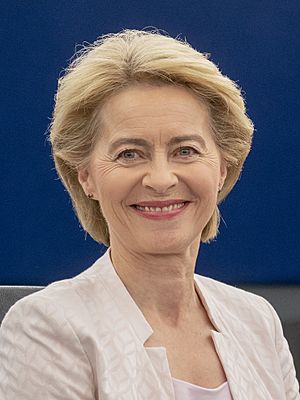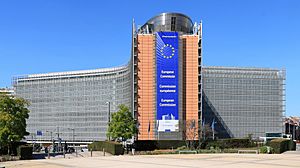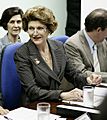European Commission facts for kids
Quick facts for kids European Commission |
|||||||||||||||||||||||||||||||||||||||||||||||||||
|---|---|---|---|---|---|---|---|---|---|---|---|---|---|---|---|---|---|---|---|---|---|---|---|---|---|---|---|---|---|---|---|---|---|---|---|---|---|---|---|---|---|---|---|---|---|---|---|---|---|---|---|
|
|||||||||||||||||||||||||||||||||||||||||||||||||||
 |
|||||||||||||||||||||||||||||||||||||||||||||||||||
| Overview | |||||||||||||||||||||||||||||||||||||||||||||||||||
| Polity | European Union | ||||||||||||||||||||||||||||||||||||||||||||||||||
| Leader | President of the Commission (Ursula von der Leyen since 1 December 2019) | ||||||||||||||||||||||||||||||||||||||||||||||||||
| Appointed by | Nominated by the European Council and elected by the European Parliament | ||||||||||||||||||||||||||||||||||||||||||||||||||
| Main organ | College of Commissioners | ||||||||||||||||||||||||||||||||||||||||||||||||||
| Ministries |
33
Agriculture and Rural Development
Budget Climate Action Communication Communications Networks, Content and Technology Competition Economic and Financial Affairs Education and Culture Employment, Social Affairs and Inclusion Energy Environment European Civil Protection and Humanitarian Aid Operations Eurostat Financial Stability, Financial Services and Capital Markets Union Health and Food Safety Human Resources and Security Informatics Internal Market, Industry, Entrepreneurship and SMEs International Cooperation and Development Interpretation Joint Research Centre Justice and Consumers Maritime Affairs and Fisheries Migration and Home Affairs Mobility and Transport Neighbourhood and Enlargement Negotiations Regional and Urban Policy Research and Innovation Taxation and Customs Union Trade Translation |
||||||||||||||||||||||||||||||||||||||||||||||||||
| Responsible to |
|
||||||||||||||||||||||||||||||||||||||||||||||||||
| Headquarters |
|
||||||||||||||||||||||||||||||||||||||||||||||||||
The European Commission (EC) is like the main "government" part of the European Union (EU). It works like a team of leaders, called "commissioners," who are responsible for different areas. There are 27 commissioners, one from each EU country, including the President. They are supported by about 32,000 staff members. The Commission is divided into departments called Directorates-General (DGs), which are similar to government ministries. Each DG is led by a director-general who reports to a commissioner.
Even though each commissioner is suggested by their home country, they promise to work for the good of the entire EU, not just their own country. The Commission President, currently Ursula von der Leyen, is suggested by the European Council (the leaders of the 27 EU countries). Then, the European Parliament votes to approve the President. After that, the Council of the European Union suggests the other commissioners, working with the chosen President. Finally, all 27 commissioners as a team must be approved by a vote in the European Parliament. The current team is called the von der Leyen Commission II, and it started its work in December 2024.
Contents
History of the European Commission
The European Commission started as one of the main groups in the European Community system. This system was proposed by Robert Schuman in 1950.
How the Commission Started
The very first version of the Commission was called the "High Authority." It had nine members and began in 1951 under President Jean Monnet. This High Authority was the main executive body for the new European Coal and Steel Community (ECSC). It started its work on August 10, 1952, in Luxembourg City.
In 1958, new agreements called the Treaties of Rome created two more communities: the European Economic Community (EEC) and the European Atomic Energy Community (Euratom). Their executive bodies were called "Commissions" instead of "High Authorities." This change happened because some countries, like France, wanted the Council to have more power than these new executive groups.
Louis Armand led the first Euratom Commission. Walter Hallstein led the first EEC Commission, holding its first official meeting on January 16, 1958. His Commission helped create important agreements and made a good impression on other countries. Hallstein also started to bring together European laws, which began to affect national laws. At first, his group was not taken very seriously. But with help from the European Court of Justice, his Commission became strong. This helped future Commissions be seen as more important.
In 1965, there were disagreements between the French government and other member states. This led to a crisis where France temporarily stopped attending meetings. Even though the problem was solved, it led to changes in leadership.
Growing and Changing
The three separate executive bodies came together on July 1, 1967, under President Jean Rey. This happened because of the Merger Treaty. After this merger, the Rey Commission temporarily had 14 members. Later, the number went back to nine, with smaller countries having one member and larger countries having two. The Rey Commission finished creating the Community's customs union in 1968. It also pushed for a more powerful, elected European Parliament.
Later Commissions, like those led by Malfatti and Mansholt, worked on money cooperation. They also oversaw the first expansion of the EU in 1973, when more countries joined. With this expansion, the number of commissioners grew to thirteen. The United Kingdom, as a larger member, had two commissioners. This larger Commission, led by Ortoli, managed the expanded community during a time of economic challenges.
The EU's presence on the world stage grew when President Roy Jenkins became the first President to attend a G8 summit. After Jenkins, Gaston Thorn's Commission helped the Community expand further south. It also started work on the Single European Act, which aimed to create a single market.
Jacques Delors' Time

The Commission led by Jacques Delors was seen as very active and gave the Community clear goals. Delors and his team are also considered important in the creation of the euro currency. Many people believed that Delors helped the European Community become strong again when it was facing difficulties. He encouraged Europe to work towards a single market and later pushed for even bigger goals like economic and political unity.
Jacques Santer's Commission
After Delors, Jacques Santer became President. In 1999, the entire Santer Commission had to resign because of issues related to how things were managed. This was the first time a whole team of commissioners had to step down. This event showed that the European Parliament had gained more power. In response to these issues, the European Anti-Fraud Office (OLAF) was created to help prevent similar problems in the future.
Romano Prodi's Leadership
After Santer, Romano Prodi took office. New agreements had given the Commission more powers. The Treaty of Nice, signed in 2001, gave the Presidents more power over how the team of commissioners was put together.
José Manuel Barroso's Commissions
José Manuel Barroso became president in 2004. The Parliament again showed its power by disagreeing with some of the people Barroso suggested for his team. Because of this, Barroso had to change his team before they could start work. His first Commission was also the first full Commission after the EU expanded to 25 members in 2004.
In 2007, Romania and Bulgaria joined the EU, increasing the number of commissioners to 27. The Treaty of Lisbon, which became active in December 2009, changed how the President of the European Commission is chosen. It said that the results of the most recent European elections should be considered. The European Council still suggests the President, but the European Parliament now "elects" them, rather than just "approving" them.
Jean-Claude Juncker's Commission
In 2014, Jean-Claude Juncker became President of the European Commission. He appointed Martin Selmayr as his chief of staff, who became very influential during Juncker's time as President.
Ursula von der Leyen's Commissions

In 2019, Ursula von der Leyen was appointed as President of the European Commission. She shared her plans with the European Parliament on July 16, 2019. She was not originally expected to be the candidate, but the European People's Party nominated her after the European Parliament election. In September 2019, the Council of the European Union announced a list of candidate-commissioners, who were then approved by the Parliament.
In September 2024, Von der Leyen announced her new team of European Commissioners. This team was designed to be more focused and connected. It included six executive vice-presidents (EVPs) from different countries. These EVPs were given the job of overseeing various groups of commissioners and leading important policy areas like prosperity, security, and democracy. New roles were also created, such as the Commissioner for Defence and Security and the Commissioner for the Mediterranean.
What the Commission Does
The Commission was created to be an independent authority, separate from national governments. Its members are suggested by their home countries, but they must act independently. They do not represent their country in the Commission. This is different from the Council of the European Union, which represents governments, and the European Parliament, which represents citizens.
The Commission has several important jobs:
- It develops plans for the future.
- It writes new laws and helps guide them through the law-making process.
- It represents the EU in trade talks with other countries.
- It creates rules and regulations, for example, about fair competition.
- It prepares the budget of the European Union.
- It checks that EU laws are being followed.
Executive Power
The Commission holds most of the executive power in the EU. This means it is responsible for carrying out the laws and decisions. Before the Treaty of Lisbon, the Council had more power to give or take away these responsibilities. Now, the Commission uses its powers directly because of the treaties.
Proposing New Laws
The Commission is unique because it is the only EU body that can formally propose new laws. Other parts of the EU government cannot start new laws on their own. This helps make sure that EU laws are well-planned and consistent. The Council and Parliament can ask the Commission to write laws, and the Commission usually does.
Under the Lisbon Treaty, EU citizens can also ask the Commission to propose a law. They do this through a petition with one million signatures. However, the Commission does not have to agree to every request.
The Commission often proposes laws about economic rules. It also suggests laws based on a "precautionary principle." This means it proposes rules to prevent harm to the environment or human health, even if the full danger is not yet known. For example, it has proposed rules to fight climate change and control genetically modified organisms. The European Commission has set a goal for EU countries to have zero net carbon emissions by 2050.
The Commission has also started to create European criminal laws. For example, after a toxic waste spill in 2006, the Commission looked into laws against toxic waste. This led to ideas for "ecological crimes."
Making Sure Laws Are Followed
Once the Council and Parliament pass a law, the Commission is responsible for making sure it is put into practice. It does this by working with member countries or through its own agencies. The Commission also makes sure that EU money is spent correctly, working with the Court of Auditors.
The Commission also has a duty to make sure that the EU treaties and laws are followed. If a member country or another institution is not following the rules, the Commission can take them to the European Court of Justice. In this role, it is sometimes called the "Guardian of the Treaties."
Finally, the Commission helps represent the EU to the rest of the world. It represents the EU in groups like the World Trade Organization. The President of the Commission also usually attends meetings of the G7 group of leading industrial nations.
The College of Commissioners
The Commission is made up of a team called the "College of Commissioners." There are 27 members, including the President and vice-presidents. Each member is suggested by their home country, but they are not supposed to represent their country's interests. Instead, they work for the whole EU. The President gives each commissioner a specific area of responsibility, called a "portfolio." The power of a commissioner depends a lot on their portfolio. For example, the Competition Commissioner has a very important role that affects many countries.
Before the Commission can start its work, the entire team must be approved by the Parliament. Commissioners are helped by their own personal teams, called "cabinets," who give them political advice. The larger staff of the Commission (the DGs) handles the technical work.
How Commissioners Are Chosen
The President of the Commission is chosen in a special way. First, the European Council suggests a candidate, taking into account the results of the latest European Parliament elections. Then, the European Parliament votes to approve this candidate. If the Parliament does not approve the candidate, the European Council must suggest another one within a month.
After the President is chosen, and the High Representative is appointed by the European Council, each other Commissioner is suggested by their home country. This is done in talks with the Commission President and the Council of the European Union, which officially approves the list of candidates.
The President's suggested team of commissioners then goes through hearings in the European Parliament. During these hearings, the Parliament questions the candidates. Then, the Parliament votes on whether to approve the whole team. If the Parliament does not like a candidate, the President must either change their role or ask the country to suggest a new candidate. This is done to avoid the Parliament rejecting the whole team. Once the Parliament approves the team, the European Council formally appoints them.
After the team is appointed, the President chooses some commissioners to be Vice-presidents. Vice-presidents manage policy areas that involve several commissioners. One of these is the High Representative, who is automatically a Vice-president. The High Representative also helps coordinate the EU's foreign relations and defense cooperation. The von der Leyen Commission also created "Executive Vice-presidents." These are more senior Vice-presidents who manage the Commission's top priority policy areas.
How Commissioners Can Be Removed
The European Parliament can remove the entire team of commissioners if it passes a "vote of no-confidence." This requires a two-thirds vote.
Only the President can ask an individual commissioner to resign. However, individual commissioners can be forced to leave if they break their duties and the European Court of Justice rules against them.
How the Commission Is Organized
The Commission is divided into departments called Directorates-General (DGs). These are like government ministries. Each DG covers a specific area, such as agriculture, justice, or human resources. A director-general leads each DG and reports to a commissioner. A commissioner's work can be supported by several DGs. The DGs prepare proposals for the commissioners. If a majority of commissioners approve these proposals, they are sent to the Parliament and Council for review.
The Commission's staff is led by a Secretary General. The current Secretary General is Ilze Juhansone.
In September 2012, the Commission employed over 23,800 officials and temporary staff. In addition, there were over 9,200 "external staff" like trainees. The largest department is the Directorate-General for Translation, with over 2,300 staff members. The largest group of staff by nationality is Belgian, likely because most of the staff (over 17,600) are based in Belgium.
Talking to the Press
The Commission talks to the press through its Directorate-General Communication. The Commission's main spokesperson is Eric Mamer. He holds daily press briefings, often called the "Midday Presser." These briefings happen every weekday in the Commission's press room in the Berlaymont building. Journalists can ask questions to Commission officials and expect official answers, often live on TV. This kind of open press briefing is quite unique.
The Spokesperson's Service helps the President and commissioners communicate effectively. The chief spokesperson reports directly to the President on political communication matters.
It has been noted that the press releases from the Commission are very political. They often go through many drafts to highlight the Commission's role and explain the EU's actions. This can make them long and complex. When many departments are involved, a press release can also show competition between different areas of the Commission. This leads to a very high number of press releases, which is seen as a unique part of the EU's political system.
There are many journalists in Brussels. In 2020, media outlets in every EU country had a journalist based in Brussels. Even though there have been fewer journalists worldwide, many news organizations feel they can cover the EU using the Commission's press releases and services like Europe by Satellite.
Important Initiatives
Fighting Terrorism
The European Commission has a plan to improve readiness against chemical, biological, radiological, and nuclear (CBRN) security risks. This is part of its anti-terrorism efforts from October 2017. Europe has faced a higher threat level from CBRN attacks. Because of this, the Commission's plan for readiness is very important. For the first time, the European Commission said that medical readiness for CBRN attack threats is a top priority.
Responding to COVID-19
The European Commission organized a video meeting of world leaders on May 4, 2020. The goal was to raise money for developing COVID-19 vaccines. They successfully raised US$8 billion.
In February 2020, the European Commission released a new long-term data plan. This plan aims to make all parts of EU society more digital. The goal is to help citizens and the economy grow.
This data strategy wants to create a single market for data. In this market, data can flow easily across the EU and between different areas, while still protecting privacy. The goal is for access rules to be fair and for the European economy to benefit greatly from this new data economy, becoming a major player globally.
Where the Commission Is Located
The main political home of the Commission is in Brussels, Belgium. The President's office and the Commission's meeting room are on the 13th floor of the Berlaymont building. The Commission also works from many other buildings in Brussels and in Luxembourg City. When the Parliament meets in Strasbourg, the Commissioners also meet there to attend the Parliament's discussions.
The members of the Commission and their immediate teams are also based in the Berlaymont building in Brussels. Additionally, the European Commission has scientific facilities in: Ispra, Italy; Petten, Netherlands; Karlsruhe, Germany; Geel, Belgium; and Seville, Spain. There is also a Commission site in Grange, County Meath, Ireland.
Images for kids
-
Walter Hallstein, the first President of the Commission
-
Jacques Delors, the European Commission president from 1985–1994
-
Incumbent President von der Leyen
See also
 In Spanish: Comisión Europea para niños
In Spanish: Comisión Europea para niños









